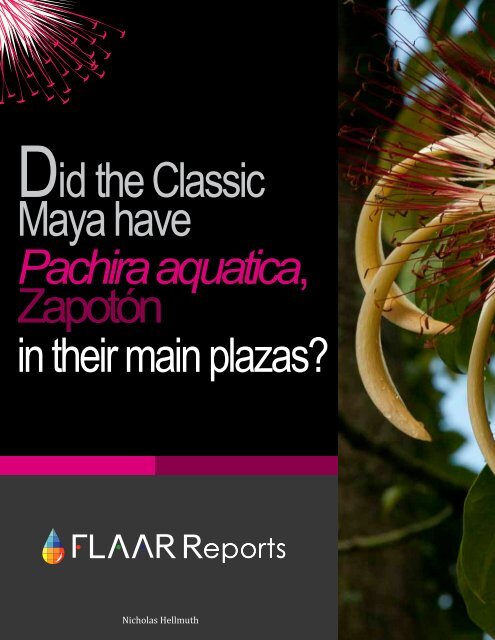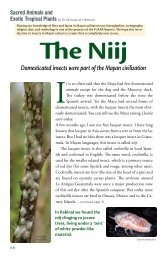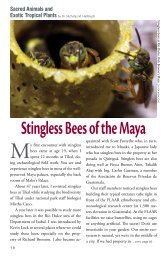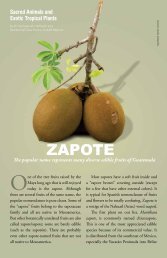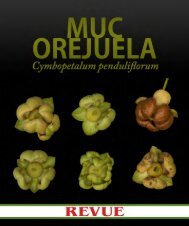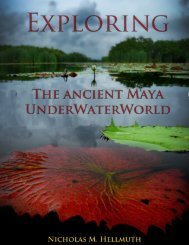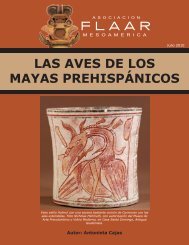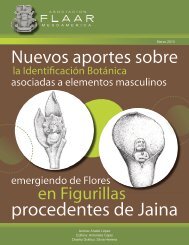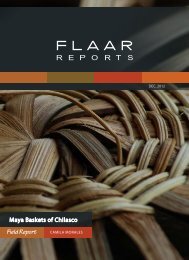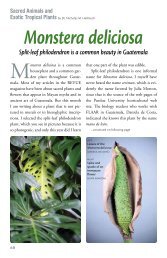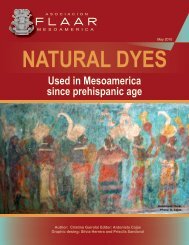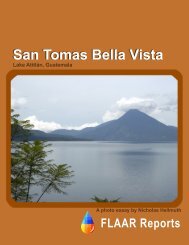Did the Classic Maya have Pachira Aquatica Zapotòn
Did the Classic Maya have Pachira Aquatica Zapotòn
Did the Classic Maya have Pachira Aquatica Zapotòn
- No tags were found...
Create successful ePaper yourself
Turn your PDF publications into a flip-book with our unique Google optimized e-Paper software.
<strong>Did</strong> <strong>the</strong> <strong>Classic</strong><strong>Maya</strong> <strong>have</strong><strong>Pachira</strong> aquatica,Zapotónin <strong>the</strong>ir main plazas?Nicholas Hellmuth1
Introduction:Normally <strong>Pachira</strong> aquatica grows alongside rivers or lakes. The fruitsdrop into <strong>the</strong> water, or along <strong>the</strong> wet shore area, and germinate. I <strong>have</strong>seen seeds germinate in standing water (along Rio Dulce). In our ownethnobotanical garden, we <strong>have</strong> put seeds in a bowl of water and <strong>the</strong>ygerminate.But seeds also germinate in soil (including in our own ethnobotanicalgarden). And although this tree clearly prefers to grow physicallyadjacent to a river or lake or swamp, it will also grow inland. In RioDulce, near <strong>the</strong> Tortuguero marina and hotel, <strong>the</strong>re is an entirelive-fence line of <strong>Pachira</strong> aquatica that are perhaps several metersabove <strong>the</strong> surface of <strong>the</strong> river and about 100 meters from <strong>the</strong> shore.Thus, although <strong>Pachira</strong> aquatia’s natural habitat is near standing orflowing water, it can indeed be grown far from water (if planted and if<strong>the</strong> seed is watered until it germinates). I <strong>have</strong> a dozen seedingshappily growing at almost 1500 meters elevation in Guatemala City.We <strong>have</strong> a separate report on planting zapoton seeds.The purpose of <strong>the</strong> present FLAAR Report is to document that <strong>Pachira</strong>aquatica can be grown anywhere in Guatemala (at least up to 1500meters elevation). Most Peten <strong>Maya</strong> cities were between 150 and 250meters above sea level (Tikal is an average of 243 meters, if I canremember from when I worked <strong>the</strong>re, at age 19, in 1965!).It would be helpful if people in Guatemala, Mexico, Belize, Honduras,or El Salvador, could alert me if <strong>the</strong>y know of <strong>Pachira</strong> aquaticaflowering above 1500 meters. The tree in <strong>the</strong> botanical garden inGuatemala city is at least 1200 meters elevation (<strong>the</strong> FLAAR facilitiesare a bit higher in <strong>the</strong> suburbs, but we are only about 8 km from <strong>the</strong>botanical garden).I am not suggesting whasoever that <strong>the</strong> natural habitat of <strong>Pachira</strong>aquatica is at high elevations. Likewise I am not at all suggesting that<strong>the</strong> natural environment of <strong>Pachira</strong> aquatica is far from rivers or lakes.The point of our studies of this sacred tree flower are to suggest that<strong>Maya</strong> gardeners of <strong>the</strong> High Priests and ruling class could <strong>have</strong> easilytransported seeds to anywhere in Mesoamerica and had trees grow,and flower, in almost any environment. For example, I also raise cacaoin my office; outside on <strong>the</strong> terrace it blooms, and bears fruit (yes,<strong>the</strong> cacao is seemingly self-pollinating, as I doubt <strong>the</strong>re are any cacaomidges in <strong>the</strong> middle of Guatemala City and at our elevation).2
The purpose of documenting that <strong>Pachira</strong> aquatica can grow far away from a river or lake is tosuggest that <strong>the</strong> <strong>Classic</strong> <strong>Maya</strong> had this tree in <strong>the</strong>ir plazas and around <strong>the</strong>ir temples. We will assume<strong>the</strong> <strong>Classic</strong> <strong>Maya</strong> had sacred Ceiba pentandra and related sacred trees in <strong>the</strong>ir religions compounds.To document <strong>the</strong> likelihood that <strong>Pachira</strong> aquatica can easily be grown, and can flower profusely,far from a river or lake, I show <strong>the</strong> <strong>Pachira</strong> aquatica in <strong>the</strong> main plaza of Chisec, Alta Verapaz. Theelevation of Chisec is about 230 meters.Actually this specific tree (and some o<strong>the</strong>rs along <strong>the</strong> Rio de San Pedro Martyr, at <strong>the</strong> town ofNaranjo, northwestern Peten) are <strong>the</strong> first <strong>Pachira</strong> aquatica that I really paid attention to. During <strong>the</strong>1970’s through 1990’s I studied primarily <strong>the</strong> sacred water lily. But since <strong>the</strong> water lily is ra<strong>the</strong>robviously in rivers and lakes, I began to notice <strong>the</strong> flowers on trees alongside <strong>the</strong> lakes as well.Then I began to notice <strong>the</strong> <strong>Pachira</strong> aquatica tree in <strong>the</strong> main plaza of Chisec. When I go on fieldtrips to photograph plants, insects, reptiles, etc, I tend to prefer to drive to Peten via Coban andChisec, since this route is more visually interesting than <strong>the</strong> normal route via Rio Dulce. I first saw<strong>the</strong> <strong>Pachira</strong> aquatica in <strong>the</strong> main plaza of Chisec perhaps five to eight years ago.On a recent annual Christmas natural science photography week, I again passed through Chisec afew days after Christmas 2011. I prefer to escape <strong>the</strong> annual ritual of parties with excesses of toomuch food and alcohol by going to remote areas to study flora and fauna. So this year we went to<strong>the</strong> Lachua area of Alta Verapaz, to study trees with blood sap and happened also to find manypochote trees. On <strong>the</strong> way back to Guatemala City we drove through Chisec, and since <strong>the</strong> tree wasin full bloom, I stopped for an hour to photograph it. We also <strong>have</strong> video (which will take months toprocess, since during a recession <strong>the</strong>re is not much funding).5
<strong>Pachira</strong> aquatica trees tend to bloom much of <strong>the</strong> year. This differentiates <strong>the</strong>m from <strong>the</strong> rest of<strong>the</strong> Bombacaceae family which tend to lose <strong>the</strong>ir leaves for a few months and bloom profuselyonly a short period.So on <strong>the</strong> following pages are some of <strong>the</strong> photographs from <strong>the</strong> FLAAR Photo Archive ofsacred <strong>Maya</strong> flowers. We now <strong>have</strong> almost a thousand photographs of <strong>Pachira</strong> aquaticaflowers, buds, and fruits. Actually fruits are often not visible: often no fruit results! Weencourage botanists to raise this question and suggest answers (heavy rain, lack of pollination,etc). But all <strong>the</strong> flowers are surrounded by stingless bees and o<strong>the</strong>r insects, so I am not sureit is lack of pollination.But <strong>the</strong>re was not one single fruit on this entire tree in Chisec, and I <strong>have</strong> seen trees at RioDulce that also <strong>have</strong> no fruits. But obviously o<strong>the</strong>r trees nearby <strong>have</strong> at least some fruits.6
We hope that this photo essay on a <strong>Pachira</strong> aquatica that is far far from any river or lake willdocument for <strong>Maya</strong> archaeologists that most <strong>Maya</strong> cities and villages probably also could<strong>have</strong> had <strong>Pachira</strong> aquatica trees in <strong>the</strong>ir main plazas and around <strong>the</strong>ir temples.I would also add that <strong>the</strong> main plaza of Chisec, in a <strong>Maya</strong>n-language area of Alta Verapaz,had a large Ceiba pentandra tree in <strong>the</strong> center. This we know from <strong>the</strong> Spanish conquerors,that <strong>Maya</strong> towns had Ceiba trees. There were o<strong>the</strong>r flowering trees in <strong>the</strong> same plaza ofChisec. It would be interesting if some of <strong>the</strong> o<strong>the</strong>r flowering trees were also sacred to <strong>the</strong>ancient <strong>Maya</strong> or at least had medicinal properties. Most of <strong>the</strong> o<strong>the</strong>r trees were not floweringenough to allow me to take good photographs. Ceiba pentandra I can identify easily withoutneeding any flowers.7
NotesIf you go to <strong>the</strong> Internet for Tikal you get many different elevations. That is because Tikal is very hilly, andif you are up in <strong>the</strong> base of Temple IV, or in <strong>the</strong> South Acropolis, you could easily be well over 230 meters(would <strong>have</strong> to check records of <strong>the</strong> University of Pennsylvania, or <strong>the</strong> Spanish team or Guatemalanteams working at Tikal).Also, not all <strong>the</strong> information on <strong>the</strong> Internet is accurate; most web sites simply copy what <strong>the</strong>y seeelsewhere.O<strong>the</strong>r figures given for Tikal from miscellaneous Google searches are:125 meters128 m174 m193 m.AcknowledgementsI appreciate that Daniela da’Costa and Cesar took time off from <strong>the</strong>ir families to accompany me during<strong>the</strong> Christmas week of photography in Rio Dulce and that Sofia Monzon and Estuardo Torres make timein <strong>the</strong>ir December schedule to join us in Coban for <strong>the</strong> days of botanical studies around Alta Verapaz.This field trip of about 9 days harvested lots of photos of Ceiba, pochote, dahlia, ceiba borer insect, and adozen fruits and spices in villages near Rio Dulce. For guiding us to <strong>the</strong> villages around Rio Dulce, Izabal,we thank Kevin Lock, a guide at Rio Dulce who raises plants and is interested in local flora and fauna.During <strong>the</strong> long drive from Rio Dulce to Lachua park area I was also able to find, and photograph, three“ceiba caves” that is, giant ceiba trees with literal caves in <strong>the</strong>m. These Ceiba pentandra were so largethat <strong>the</strong> rotted spaces at <strong>the</strong>ir lower trunks were large enough to walk into. These “ceiba caves” arehomes for bats and insects. I believe <strong>the</strong>se caves are <strong>the</strong> source of paintings on Codex Style vases thatshow trees with a frontal face at <strong>the</strong> base (though those trees on <strong>the</strong> Codex Style vases <strong>have</strong> leaves andfruits which are totally different than a Ceiba pentandra tree).There will be a forthcoming FLAAR Report on <strong>the</strong> “ceiba caves,” as soon as we process <strong>the</strong> highresolution photographs. We are using a 21 megapixel Canon EOS-1Ds Mark III, provided courtesy ofJohn Lorusso, Parrot Digigraphic, a company dedicated to glicee and fine art photography, scanning,color management, and wide-format inkjet printers. The donation of equipment of high resolution andprofessional quality is significant for this project.We also appreciate <strong>the</strong> Gitzo tripods provided by Bogen Imaging several years ago (<strong>the</strong>y are nowManfrotto Distribution). The stability of <strong>the</strong>se tripods, and <strong>the</strong> fact that <strong>the</strong>y are high enough, really helpsour photography.8
10If you look at <strong>the</strong> photographs, you can see <strong>the</strong> results of having good equipment, pluslogically it helps to <strong>have</strong> learned by trial and error over many decades. You can learnabout how to do photography of flowers on our www.digital-photography.org and ourwww.maya-ethnobotany.org.


